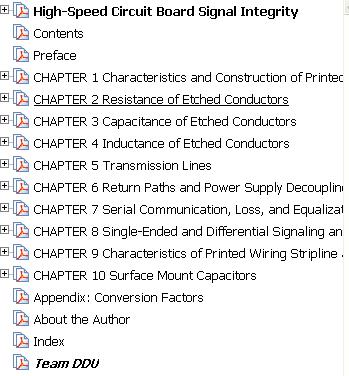
资料下载

高速电路板信号完整性
高速电路板信号完整性:This is a book for engineers designing high-speed circuit boards. To the signal integrity
engineer, this book will be a handbook of formulas and terminology as well as a
refresher of basic electrostatic and electromagnetic principals. The high-speed circuit
designer will find this book an easy entry into the electromagnetics and physics
of high-speed signaling. It introduces concepts fundamental to high-speed signaling,
such as lossy transmission line behavior, skin effect, and the characteristics of laminates
and surface mount capacitors. The focus throughout is on the effects of dielectric
and conductor loss on signal quality, with a particular emphasis on serial
differential signaling. Coupling between transmission lines (especially in the context
of crosstalk and odd/even modes) is discussed. Besides being useful in serial signaling,
this has application to multiconductor busses.
Reflections on transmission lines are only superficially covered in this text. This
topic has been extensively covered in the literature, and the reader of this book is
assumed to be familiar with the creation and mitigation of reflections on transmission
lines. However, the proper routing and termination of differential pairs has not
been as well covered in the literature and so is discussed in Chapter 8.
Similarly, power supply decoupling has been thoroughly discussed elsewhere,
so the coverage in this book is brief. Instead, the focus here is on managing return
paths (something often not well covered) and the electrical characteristics and
behavior of capacitors. The material in Chapter 10 is a concise catalog of essential
electrical characteristics of discrete capacitors, with a focus on surface mount
technology.
The fundamentals of resistance, capacitance, inductance, and loss calculations
presented in Chapters 2–5 are illustrated with practical worked examples that may
be used as templates to solve similar problems.
Many simple formulas are presented to allow hand calculation of resistance,
capacitance, inductance, and impedance. These types of calculations are helpful in
developing intuition and in approximating beforehand the results to be expected
from field solving software, circuit simulation tools, and laboratory measurements.
Extensive references are given at the end of each chapter, providing the interested
reader the opportunity to dig deeper. The references intentionally span classic,
older works (some of which were written in the 1950s, but most of the older ones
are from the 1960s and 1970s) as well as modern works. The older references are
valuable, as they are the original works often cited by others, sometimes without the
proper context. Although long out of print, the selected older references are generally
available secondhand and are worthy additions to the signal integrity engineer’s
library. Particular mention is made of Johnson’s Transmission Lines and Networks (published in 1950, referenced in Chapter 2) and Skilling’s Electrical Engineering
Circuits (1965, see the references in Chapter 3) and Transient Electric Currents
(1952). These books are succinct and in my view remain unmatched. Miner’s Lines
and Electric Fields for Engineers (1996, first referenced in Chapter 3) is the one electromagnetics
textbook every signal integrity engineer should have in his or her
library.
I’m indebted to my friends and coworkers for their support, encouragement,
and help during the creation of this book. Special mention must be made of the assistance,
perspective, and advice provided by my colleagues Jeff Cooper, Ernie Grella,
and Tim Haynes. Special thanks also goes to Fahrudin Alagic for his many months
of precise laboratory measurements that support the material appearing in Chapters
5–7. I’m grateful to all of those who suffered through early versions of the manuscript
for their constructive remarks. I’m also obliged to the anonymous reviewer for
his insightful comments. All of these comments were most helpful and have resulted
in an improved text. Of course, any inaccuracies or errors that made it into the text
are my doing and in no way reflect on the reviewers.
Finally, I’m especially grateful to my wife Ann for her understanding, patience,
encouragement, and unflagging support throughout the many long hours it took to
create this work. This book would not have been possible without her.

声明:本文内容及配图由入驻作者撰写或者入驻合作网站授权转载。文章观点仅代表作者本人,不代表电子发烧友网立场。文章及其配图仅供工程师学习之用,如有内容侵权或者其他违规问题,请联系本站处理。 举报投诉
- 相关下载
- 相关文章






